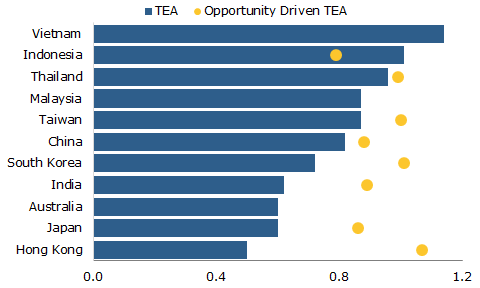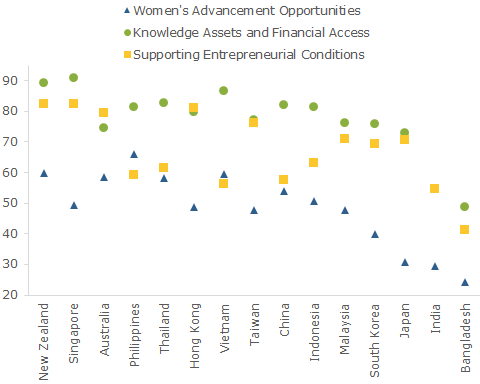Across the globe, an estimated 163 million female entrepreneurs run their own businesses.1 While this figure is impressive, women entrepreneurship still lags men: in 2018, there were only seven women entrepreneurs for every ten men. The disparity is a result of a variety of factors, including access to education, financing, opportunity, and cultural support. This blog explores a growing body of analysis to assess how female entrepreneurs fare in Asia relative to male counterparts. Across the region, participation in entrepreneurship is strongly driven by necessity, as women in many economies face a lack of alternative options. While a strong entrepreneurial ecosystem supports founders of both genders, research indicates that cultural perceptions of women and female representation in leadership roles also play an important part in encouraging women to participate in entrepreneurial activities. Both local and multilateral initiatives are underway across Asia to help level the playing field for women in business. These gender-focused policies are working to ensure women have access to funding, networks, information, and support, and are establishing a path toward greater gender parity in entrepreneurial activity.
How do female entrepreneurs fare in Asia?
On a global scale, men are more likely to be involved in entrepreneurial activities than women. Gender parity varies greatly by region, however, and the East and South Asia region in particular shows higher gender equality than economies in other regions. Moreover, according to the Global Entrepreneurship Monitor (GEM), rates of entrepreneurship among women match or exceed that of men in three economies: Vietnam, Indonesia, and Thailand (Figure 1). On the other end of the spectrum, GEM reports some of the largest discrepancies between male and female entrepreneurship in the developed Asian economies. As seen below, Hong Kong, Japan, and Australia all report rates of female entrepreneurship closer to half the rate of male entrepreneurship. Despite these low figures, there is some encouraging news that circumstances are shifting. In Japan, for example, the small but growing group of women entrepreneurs is driving the expansion of new businesses; in 2018, Japan’s total entrepreneurial rate, while still very low, rose above 5 percent due to a jump in the number of women entrepreneurs. The trend is a potential sign that Prime Minister Abe’s ‘womenomics’ platform to support and engage women in the labor force may be yielding dividends.
As the rankings suggest, the level of a country’s economic development does not always correlate with gender parity in entrepreneurship. Rather, high rates of female entrepreneurship in lower-income economies often reflects the fact that necessity is often the strongest driver for entrepreneurship, where individuals have no better employment options other than starting their own business. Very few entrepreneurs in India, for example, report being motivated to improve their lives through entrepreneurial pursuits. Rather, they most often start businesses because there are no better work options.
Female Entrepreneurship in Asia

Total Entrepreneurial Activity (TEA) is equal to the percentage of female 18-64 population who are either a nascent entrepreneur or owner-manager of a new business, divided by the equivalent percentage for their male counterpart. Based on latest available data between 2016 and 2018.
Opportunity-driven entrepreneurship—with individuals citing either higher income or greater independence as the impetus—tells a slightly different story. Here, most higher-income economies in Asia including Hong Kong, South Korea, and Taiwan generally report opportunity-driven entrepreneurial rates closer to parity between men and women. Japan, however, remains a key outlier, reporting a considerable difference in 2018 between men and women in opportunity-driven pursuits, a gap which stretches notably larger when both necessity and opportunity driven entrepreneurial activity are included.
Factors affecting female participation in entrepreneurship go beyond just the level of national income and development to include infrastructure and culture. The next section provides an assessment of some of these underlying factors, and looks at how these components contribute to female entrepreneurship across the Asian economies.
What are the key factors supporting women in entrepreneurship?
The GEM study provides one framework for assessing country’s entrepreneurial ecosystem, looking at factors related to educational training and attainment, domestic infrastructure, government policies, and cultural and social norms.2 Overall, GEM’s index results are consistently high in East and South Asia. Three economies in Asia rank in the top five (among the nearly 50 economies surveyed globally): Taiwan, which scores highly on every framework condition, and Indonesia and India, which have high ratings in every category except for physical infrastructure. The report notes that some of the economies ranked highest for having a strong ecosystem for entrepreneurs—including Indonesia and Taiwan—also report comparable participation rates in entrepreneurial activities across men and women, suggesting that domestic business conditions could have differentiating effects on men and women.
Taking the analysis one step further, Mastercard evaluates conditions specifically for women in entrepreneurial activities and business.3 These include factors such as female representation among business and political leaders, female financial inclusion, and cultural perceptions of women entrepreneurs. In Mastercard’s 2018 Index, four of the top ten economies for female entrepreneurs globally were in Asia. The highest ranked economies in the Mastercard index were more developed: New Zealand (at the top spot globally for the second year in a row), Singapore, and Australia (Figure 2). Access and infrastructure were important factors. All three ranked highly on factors related to a supportive entrepreneurial environment, including ease of doing business, quality of governance, quality of legal and educational infrastructure. Likewise, each generally received high marks in terms of female financial inclusion, educational attainment, and SME support. Despite this strong foundation, they were not the highest ranked in terms of women’s advancement opportunities, which covered female representation as business leaders, professional and technical workers, and entrepreneurs.
Index of Women Entrepreneurship

There were a few outperformers in the Mastercard Index among emerging market Asian economies. The Philippines (ranked 9th overall), Thailand (15), and Vietnam (18) offered competitive environments for female entrepreneurs, and demonstrated some of the best opportunities for women’s advancement. In fact, the Philippines ranked highest globally in supporting women’s advancement outcomes, with the country boasting the highest share of senior management team roles held by women across the region.4 As noted in the GEM report, women in the Philippines (based on 2015 data) are just as likely as men to engage in entrepreneurial activity, as are women in Thailand and Vietnam. In contrast to their more developed peers, however, entrepreneurial conditions writ large were rated as weaker.
How are policies supporting female entrepreneurship?
Proactive government policies are helping to narrow the gap between male and female participation in entrepreneurship. In the Philippines, for example, the Magna Carta of Women promotes gender equality in all facets of economic, social, and political life. Since 2006, the legislation has laid out goals for gender balance in the upper echelons of government, non-discrimination and equal access to education and employment, and the use of mass media to raise public consciousness and recognition for the dignity of women. Buffeted by gender-responsive budgeting at the national and local levels and annual implementation plans, the Philippines has fully closed the gap in educational attainment between men and women and helped the country achieve a high proportion of women in leadership positions, as noted above. Elsewhere, the government of Sri Lanka is working with the Asian Development Bank to implement a program on “Enabling an Empowering Business Environment for Women Entrepreneurs in Sri Lanka”. With $12.6 million allocated to the program during the first round of funding, the program is designed to improve access to credit for women-led SMEs and provide resources and support for capacity building. Nearly $3 million in grants has already been distributed to women-led SMEs, while 500 female entrepreneurs will begin capacity building training in May 2019. The program’s next steps include laying the foundation for gender inclusive policy, regulatory framework, and impact evaluation.
Multilateral institutions in Asia are also moving forward with a number of programs to support further gains in female entrepreneurship. The range includes programs to increase access to funding, mentorship, and knowledge for female entrepreneurs. A small handful of these initiatives include:
- The United Nation’s Economic and Social Commission for Asia and the Pacific (ESCAP) launch of the Innovation Fund in 2019, targeted at women in micro, small, and medium enterprises (MSME). The Fund provides financing, technical assistance, mentoring, and investor networking to companies piloting innovative digital and financial solutions that improve access to finance and/or enhance operational efficiency of women-led MSMEs. Target countries include Bangladesh, Cambodia, Fiji, Myanmar, Nepal, Samoa, and Vietnam. Outside of the Fund, the ESCAP has called for women entrepreneurship bonds, impact investment funds, and gender responsive fintech solutions.
- The ASEAN Women Entrepreneurs Network (AWEN), a regional network of business women working collectively on initiatives to promote gender equality and strengthen entrepreneurship skills for women.
- The Gender-Responsive Economic Actions for the Transformation of Women (GREAT Women). Piloted first in the Philippines, the program has expanded to support female entrepreneurs and business owners improve sustainability, productivity, and competitiveness across the ASEAN economies.
So what’s the bottom line?
While women have made headway in entrepreneurship and business leadership in recent years, they have further to go. There is a growing consensus that improving structural factors that support entrepreneurship broadly—regulatory and legal frameworks, access to education, and financial resources—should be an inherent part of the development process. Making further progress, however, requires gender-targeted programs to eliminate the disparity between men and women. Platforms that offer knowledge, financial support, and other resources tailored specifically to women—such as these initiatives listed above—are an important component. Last but not least, progress will also rely on cultural recognition and support for women in entrepreneurial pursuits. Though these changes may take time, they are a critical part of building an equitable economic landscape.
1. As of 2016, reported by Mastercard Index of Women Entrepreneurs 2018.
2. The 12 framework conditions assess entrepreneurial finance; government policies support and relevance; government policies, tax and bureaucracy; government entrepreneurship programs, entrepreneurship education at school stage; entrepreneurial education at post-school stage; R&D transfer; commercial and professional infrastructure; physical infrastructure; internal market dynamics; internal market burdens or entry regulation; and cultural and social norms.
3. Mastercard’s annual report covers 57 economies, representing nearly 80 percent of the world’s female labor force. The 2018 report reflects conditions in 2016. The report leverages a variety of gender-disaggregated data from GEM, the International Labor Organization, the World Bank, and others.
4. Research Paper Series No. 2018-04. Sustainable Development Goal 5: How Does the Philippines Fare on Gender Equality? Philippines Institute for Development Studies.
The views expressed here do not necessarily reflect the views of the management of the Federal Reserve Bank of San Francisco or of the Board of Governors of the Federal Reserve System.

